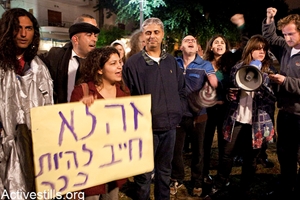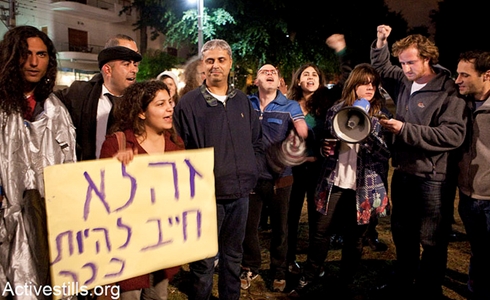
Dozens of activists returned to Tel Aviv’s Rothschild Boulevard on Monday night, as a reminder that the social justice they sought in the summer has yet to be satisfied. A few tents were set up at the northern end of the boulevard, alongside some mats, while some activists wore their tents on their bodies so as to avoid having them confiscated by municipality inspectors.
Regev Contes, who, together with Daphni Leef and Stav Shafir, was one of the social protests leaders, said the intention of Monday’s protest was not to restarts a Rothschild encampment – yet. “The intention is not to bring back the tents this winter,” said Contes. “The intention is to show that so long as the government refuses to treat this illness, the tent rash that is on the skin of Israeli society will continue to pop up over and over until it erupts again in the summer.”

Protest for social justice, Tel Aviv, January 16, 2012 (Photo: Activestills)
According to a new Ministry of Welfare and Social Services report 1,319,000 individuals, or 17.1 percent of the population, were still in need of treatment from social services in 2010. Compiled by the ministry’s Research, Training and Planning Division, the figures show a dramatic increase from the 298,000 families who received welfare treatment in 1998 to more than 447,300 families in 2010.
In addition to highlighting increased demands for social services in recent years, the report also lists key reasons people sought help in 2010.
Among the reasons: Parenting difficulties and youth behavioral problems at 35.2% of all case files; poverty or unemployment at 34.4%; elderly people at 33.3%; mental and physical disabilities at 31.9%; violence against children and general domestic violence at 4.1%; and addiction (alcohol, drug and others), prostitution and imprisonment at 3.6%.The report revealed an unusually high number of Ethiopian immigrants receiving treatment. From within the 110,000-strong community, the report found that 61.4% had open files with social services and even among those in the second generation, the chance of them having met with a social worker was twice as high as those outside the community.
Also cause for concern was the large percentage of Arab families receiving support from welfare services. Some 25% of the country’s 1.5 million Arab-Palestinians in Israel were seen by social workers in 2010, compared to 15.8% of the Jewish population.


